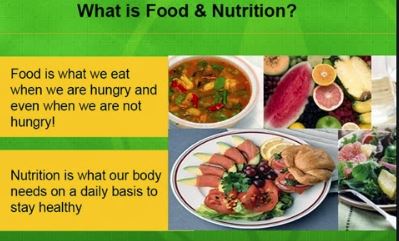What is Difference Between Food and nutrition?
Difference Between Food and nutrition is that Food is the action of living organisms to ingest any type of food, solid or liquid, to meet their biological needs.
Nutrition is the obtaining and use of those components or nutrients present in food, and that is vital for the growth and/or life of the organism.

The difference between food and nutrition is that the first action refers to the actions involved with obtaining and choosing food, and the second involves the processing and digestion of food inside the body.
The feeding generates a process of nutrition, and nutrition depends on the feeding to be carried out.
| Feeding | Nutrition | |
|---|---|---|
| Definition | It is the obtaining and selection of foods that are going to be ingested. | It is the process of digesting the food consumed to obtain its nutrients. |
| features |
|
|
| Types |
|
|
What is Alimentation?
Food is the obtaining, selection and preparation of food in order to ingest them. In the case of human beings, food can be natural or man-made, solid or liquid, may require prior processing or not (cleaning, boiling, cooking, etc.).
Food is an act that depends on many factors to be carried out, such as learning, geographic environment, social group, customs, socio-economic factors, personal preferences, health conditions, etc. Hence, although it is a universal act, it is not performed in the same way throughout the world, not even within the same social group.
On the other hand, food is an individual and voluntary act, since each person can decide how and when to feed.
It is important to note that the terms diet and diet refer to the act of choosing the foods to be consumed. When food selection has to be specific (either due to illness, as part of a weight loss program, food allergies, etc.), it is then a food plan.
Types of food
As the obtaining and selection of food depends on multiple factors, the types of food can be varied. However, there are general classifications that identify the most popular types of food.
It includes a selection of foods from all food groups (milk, meats, vegetables, vegetables, fruits, cereals and fats) in moderate amounts, which must be present at all meals that are made.
It is a type of food based on the consumption of vegetables, legumes, cereals, fruits, and fats of non-animal origin. Within vegetarianism, there are some subclassifications, such as:
- Ovolactovegetarianism: includes eggs and dairy.
- Lactovegetarianism: includes dairy
- Veganism: excludes any food of animal origin. More than a type of food, it is a practice that avoids the consumption and use of products made from animals.
MEDITERRANEAN FOOD
Also known as the “Mediterranean diet”, it is a selection of foods based on the eating habits of the inhabitants of the Mediterranean region (Spain, Portugal, Italy, France, Greece, Morocco, Cyprus, and Croatia).
This type of diet includes large amounts of vegetables, grains, fruits, legumes, and monounsaturated fats (such as that found in bluefish and nuts), while the consumption of red meat is reduced.
What is nutrition?
Nutrition is the process by which living organisms transform food into energy and matter, in order to fulfill their vital functions. This process is carried out after digesting the food to obtain the nutrients they need.
Nutrition includes the absorption of food, its digestion, metabolization, and excretion of wastes or elements that are not nutritional or that have already been used by the body.
In order for an organism to be able to nourish itself, in the sense that it can obtain the energy it needs, it is required that the selection of the food is appropriate for its needs, therefore, the type of food directly influences the quality of nutrition,
However, nutrition is a biological, physiological and involuntary process, therefore, it will be carried out once the food is ingested and regardless of its type, quality or quantity.
Types of nutrition
Depending on their type of nutrition, living things can be autotrophic or heterotrophic, depending on their primary food source.
AUTOTROPHIC NUTRITION
It is the absorption of nutrients from inorganic substances. Autotrophs produce their own food from carbon dioxide, which they obtain in any of these processes:
- Photosynthesis: is the obtaining of organic matter from the light energy. Most plants are photosynthetic autotrophs.
- Chemosynthesis: in this case, the nutrients are obtained after an oxide-reduction process of inorganic components. Bacteria, for example, are chemosynthetic autotrophs.
It is the process of synthesis of nutrients from organic substances. Heterotrophs cannot produce their own food, so they depend on other organisms to nourish themselves, be they autotrophs or heterotrophs.
Humans, animals, fungi and some microorganisms are heterotrophic and, in turn, are subclassified into three types.
- Herbivores: refers to living things that only feed on plants. In this case, your digestive system cannot process other types of organic matter. They depend directly on the autotrophs, who provide them with food by converting inorganic matter into organic matter. The rabbit, the horse, and the elephant are examples of herbivorous animals.
- Carnivores: they are the organisms that only feed on meat. To do so, they evolved to develop teeth, which are what allow them to obtain and crush the food. Coyote, dolphin, and crocodile are some carnivorous animals.
- Omnivorous: in this case, the food source is herbivorous and carnivorous. They are not adapted to feed on plants or meat exclusively, so they combine both sources. Mammals (including humans), birds and some species of fish and reptiles are omnivorous.
You May Also Interested:
